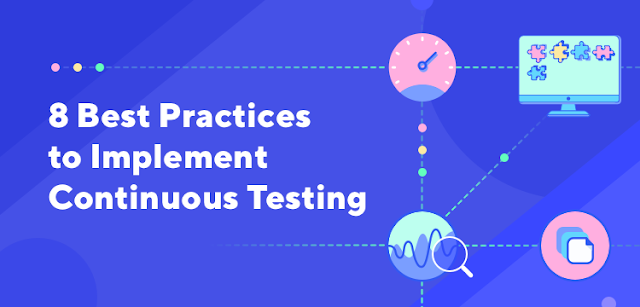Does your business plan include a continuous testing strategy? Is continuous testing right for your organization? Every company who has implemented continuous testing had to answer these questions – and not all companies are able to do so. It requires a strategic planning process and many changes would need to be put in place, which can be challenging for small and large organizations alike. After all, continuous testing is all about testing early and often which can be challenging to implement.
To find out more about continuous testing, check out our previous blog for an Introduction to Continuous Testing.
If you want to learn about best practices to implement an effective continuous testing strategy, you’ve come to the right place. After thoroughly researching continuous testing and consulting industry experts, we’ve compiled eight best practices that you should consider to help you effectively build a continuous testing strategy. We hope this helps you make the best decision for your software testing needs.
1. Adopt More Test Automation
Continuous testing is still achievable with manual testing each time code is checked in and still experience the same expected quality. However, automation increases the speed and errors coverage at which testing can function. Automating as much as you can in the development lifecycle will help you achieve faster releases. Read more on why you should apply test automation.Keep this in mind. If you are shifting from a fully manual testing procedure, don’t expect automation to happen overnight. It can take time to set up. But once you do, the time-saving benefits will definitely earn you points with your customers who won’t have to wait as long for new features. Or even getting your product to market before your competition can.
2. Tool Integration
Continuous testing is not just about automation. It involves teams using proper tools to make the testing process easier, faster, comprehensive, and more effective. Such as tools that work with the dev toolchains to remove the manual overhead (where possible). Additionally, tools that remove/reduce mundane operations for testers, enabling them to focus on what is important: testing.3. Tracking Metrics
Use quantifiable metrics to keep track of your success or failure rate during testing. Continuous testing offers immediate results to see if the software is working as expected. Hard data yield results to measure progress and quality outputs. Tracking how many bugs are found and corrected provides continuous validation for your business value ROI.Two key metrics that you need to be sure to keep track of are: counts of defects and counts of fail/pass test scripts. Tracking the number of defects discovered in your testing process will help you determine if the number increases or decreases. If it increases, strategize ways to change your development process; if it decreases, keep up the great work! Additionally, keeping track of the number of pass/fail test scripts will help you produce a comprehensive testing strategy to create better functionality for your application.
Katalon Analytics can help you effectively manage test results and insights. Learn more here.
4. Leverage Containerization
Containerization refers to the process of bundling all components of an application together – including configuration files, libraries, and dependencies – within its own operating system.Containerization makes continuous testing easier to process by keeping each service of the application in its own environment. Imagine being able to test only the specific code that you need at one time, rather than the entire application.
Also, using containers for your test environments keeps the often difficult-to-maintain environments up-to-date with the latest code changes that would be released to production. Furthermore, if the test suite fails or if the data ends up corrupted, the container can be discarded and another one set up with fresh data.
5. Keep Communication Transparent
Keep your communication lines transparent to prevent the testing pipeline from becoming siloed. Bottlenecks can form when communication between other teams or roles within the same team are not transparent, resulting in time wasted that could otherwise be spent more productively. It’s like a well-choreographed dance. The steps have been set in place and you need to learn how to move fluidly with your partner to smoothly fulfill all the steps. Active communication is the key to achieving the balance necessary to effectively carry out continuous testing.6. Save Time with Headless Execution
No, it’s not Halloween and we’re not talking about headless horsemen. Headless execution is the part of automating user interface tests that don’t incorporate the head (i.e. no browser UI or GUI). Resulting in faster execution, this process reduces the number of unnecessary caches, cookies, or resources that are sifted through to obtain the results that matter: does the application run as expected. Be sure to run a subset of your tests on a real browser before releasing to your customers. After all, users don’t operate on headless browsers! Always check your user interface through explorations to ensure all necessary areas are covered. The beauty of headless execution, though? Saving time to run the longer and more in-depth automated tests.7. Multi-layer Tests
Using a multi-layered approach to run tests ensures all areas within the development lifecycle are covered. From unit, integration (API), system (GUI), and database testing, complete automation must take multiple testing processes into consideration for thorough testing to be carried out. As software techniques become more complex (especially taking into consideration the next steps of microservices), having a multi-layer approach in place will help you keep the complexity from overwhelming proper test execution.8. Integrate Performance Testing into Delivery Cycle
How do you know if your application is working to the best of its ability? Is it running optimally or is it crashing during heavy use? Performance testing within the delivery cycle is beneficial because it checks the speed, responsiveness, and stability of your application. It’s an investigative process that observes how the system is running and find solutions to overcome those observations. As such, it should be an integral part of continuous testing. After all, if the application is not reliable or the data is not accurate, would you continue to have a great ROI?If you want to keep up the speed, maintain low effort to script, and create parallel executions with minimal interdependence, you should use tools to help you with these efforts! One of the best tools that can help with your performance testing is Neoload which works well with a continuous testing strategy.
Conclusion
Continuous testing is a great way to ensure your product is released to the market at quality customers expect. If you incorporate these best practices before implementing continuous testing within your organization, you’ll be off to a great start.Originally published at https://www.katalon.com/resources-center/blog/continuous-testing-best-practices/



No comments:
Post a Comment
Note: Only a member of this blog may post a comment.